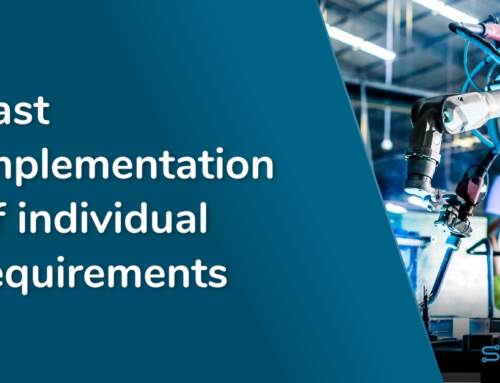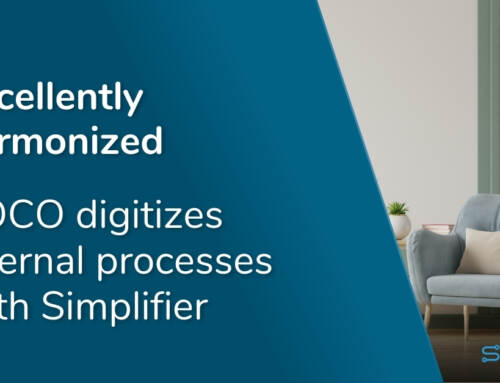Alexander R. works as a developer for a large enterprise that specializes in technology and electrical engineering. In the past, he has used coding exclusively. However, he has been working with low-code technology by Simplifier for quite some time now as well.
Even though he is a passionate pro coder, he appreciates the advantages of low-code technology. He tells us how this technology and its approach helps him with his daily doings. Now even more than before, since Simplifier is based on web technology and leverages open web standards. This entails a number of decisive advantages in the current remote work situation
(Reading time: Approximately 4 min.)
(Mobile) applications are crucial to the implementation of digitalization measures. One of the tools that can be used for creating those are low-code platforms.
Someone who has been working with a low-code-platform for quite a while now, is Alexander. Although he is a professional coder himself, Alexander sees the advantages that low-code platforms offer when it comes to building applications – and thus for the progress of digitalization processes. He and his colleagues work jointly on various applications with support from Simplifier.
Web-based
Alexander needs a platform, which allows him to work from home. He benefits from the fact that Simplifier is web-based. Even without his work laptop and without being tied to his office and the respective infrastructure, he is able to build apps and to expand already existing ones. If this were not the case, everyone involved would face a couple of difficulties. Luckily, he does not have to worry about that. His work can continue.
This currently includes creating a small MES system, which provides workers with digitalized plans and other documents, from scratch. “We have the opportunity to create everything the way we want it – we don´t have to rely on others. Additionally, we can use the other APIs”, Alexander explains.
What other advantages does he see and what other features (especially the ones that came with Release 5.0) does he benefit from? Let´s find out and take a closer look!
Saving time
First of all, it´s time-saving: The newly created UI Designer with its WYSIWYG editor leads to a drastic acceleration in terms of application creation.
„The UI Designer allows me to see the changes I am making in real-time”, Alexander says.
The result: He is a lot faster – especially since the app does not have to be deployed to see the changes made. This, in turn, entails another advantage in the current situation: “The larger the app, the longer the deployment. When the connections are overloaded – as is the case at the moment -, even more time is lost”.
What is helpful for him as a pro, represents the introduction to the field of application creation for others. The easy and intuitive usability allows for people, who have had little exposure to the issue, to participate in the application creation process and to support Alexander and his colleagues.
They can use the help. Less than ten staff members are developing apps. Nevertheless, 15 apps are live – after just a couple of months.
Naturally, those apps need to be developed further and to be optimized permanently.
Expandability
One of his colleagues is working on project management topics, another one is tasked with an incident management app with which error messages can be processed.
Changes and functional expansions keep occurring repeatedly.
Existing apps can be both adjusted and expanded at any time with low-code technology. In this particular case, the information columns of tickets could be doubled. Thus, problems can be traced much more precisely. Information content and filter functions are significantly higher and the application can be used in an even more versatile manner.
DB Designer
Permanent expansion has caused the app to grow pretty much lately. Since more tickets and ticket columns were added, the respective database has also grown accordingly.
That is why Alexander and his colleagues are thinking about recreating the app. “This would entail a massive performance enhancement”, the pro coder says. Yes, the majority of tickets can be processed. However, they are always all loading completely. “For that reason, we need a useful database structure, which displays tickets only when asked for. The currently high loading times of somewhere between 5 and 6 seconds are unacceptable – especially on the tablet”, Alexander says.
Of course, this makes a successful digitalization a lot more difficult. That is where the new DB Designer comes into play. With this new feature, it is possible to create a database fast and easily. By means of a graphical user interface, database diagrams can be designed. These allow for a deployment for various database types.
Summary
„To sum it up: Our work has not changed fundamentally by using low-code technology. However, many issues that we were not always able to solve in past, are easier to handle now. Starting with the integration of existing systems that we could not integrate and thus could not make use of the respective data, to a faster and easier implementation of user interfaces (mobile-ready) and the connected business logics. Especially the real-time preview for the different devices, that are supposed to be used, is a huge time saver. I do not work with low-code exclusively because I love coding too much. But that is the good thing about Simplifier: The easy parts are being implemented quickly with low-code and pre-configured elements. And when it comes to more complex issues, which cannot go without coding, I still have the possibility to dive into the deeper code level”, Alexander explains.






